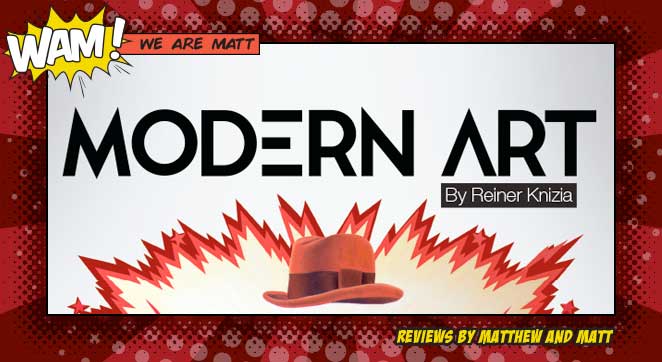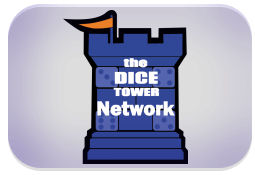Quick Board Game Reviews That Pack a Punch. No Rules, Just Opinions.


Buying and selling paintings is a very lucrative business, at least that’s what Hollywood’s led us to believe, and
that’s the premise of this game. Five different artists have produced a bunch of paintings, and it’s the player’s task
to be both the buyer and the seller, hopefully making a profit in both roles. He does this by putting a painting from
his hand up for auction each turn. He gets the money if some other player buys it, but must pay the bank if he
buys it for himself. After each round, paintings are valued by the number of paintings of that type that were sold.
The broker with the most cash after four rounds is the winner.

 One of my favorite hobbies was yahoo fantasy sports using auction drafts. There is something so satisfying about getting value for your money, and then flipping a player at the height of their buzz. Timing is everything, and the same goes for the auctions in Modern Art. There is something so satisfying watching the fervor of the bidding get out of hand, and hoping you aren’t the person who paid too much. It’s a combination of hand management, creating demand for artists, and selling them for profit, as this merry-go-round of dealers put their works of art up for sale. One of my favorite hobbies was yahoo fantasy sports using auction drafts. There is something so satisfying about getting value for your money, and then flipping a player at the height of their buzz. Timing is everything, and the same goes for the auctions in Modern Art. There is something so satisfying watching the fervor of the bidding get out of hand, and hoping you aren’t the person who paid too much. It’s a combination of hand management, creating demand for artists, and selling them for profit, as this merry-go-round of dealers put their works of art up for sale.
|
 You’ll be buying and selling artwork, and at the end of the round you’ll be selling everything you acquired for cold hard cash. The catch is that only three of the five artists, the ones who moved the most work in the round, will be assigned value based on number of works sold and receive payouts. In further rounds, savvy buyers will be able to cash in even more on an artist’s continued popularity because the value assigned to an artist’s work carries over from round to round … that is, unless the artist falls out of popularity and fails to place in the top three. With a limited number of works from each artist, you’ll need to cleverly manipulate the art market to ensure at the end you get real paid. You’ll be buying and selling artwork, and at the end of the round you’ll be selling everything you acquired for cold hard cash. The catch is that only three of the five artists, the ones who moved the most work in the round, will be assigned value based on number of works sold and receive payouts. In further rounds, savvy buyers will be able to cash in even more on an artist’s continued popularity because the value assigned to an artist’s work carries over from round to round … that is, unless the artist falls out of popularity and fails to place in the top three. With a limited number of works from each artist, you’ll need to cleverly manipulate the art market to ensure at the end you get real paid.
|

 I will be completely honest with you. This game is not for the faint of heart. There are no clues to what the values of paintings are in the first round and only later does it become more apparent. The players are in complete control of the asylum, and bidding can get crazy. You will need to do quick math on what’s profitable, and when you speculate you’d better be lucky or be holding the cards to cause the round to end in your favor. There are multiple styles of auctions and knowing which one to do and when are critical if you are going to have the most money at the end of the game. This game is hard, but like most Reiner Knizia’s game the rules are refreshingly simple. I will be completely honest with you. This game is not for the faint of heart. There are no clues to what the values of paintings are in the first round and only later does it become more apparent. The players are in complete control of the asylum, and bidding can get crazy. You will need to do quick math on what’s profitable, and when you speculate you’d better be lucky or be holding the cards to cause the round to end in your favor. There are multiple styles of auctions and knowing which one to do and when are critical if you are going to have the most money at the end of the game. This game is hard, but like most Reiner Knizia’s game the rules are refreshingly simple.
|
 Modern Art is the auctioniest auction game to ever wield a gavel, featuring not one, not, two, not six, but FOUR different types of auctions. There’s a simple, once-around auction, where each player will make a single offer; an open auction where everyone, including the auctioneer, shouts out a price; a fixed-amount sale, where the player will put a price tag on the work; and finally, my favorite, the secret bid, where everyone puts their bids in their hands behind their player screens, closes their fists, holds them over the center of the table and then reveals their bids simultaneously. Additionally, there are works that will allow you to place a second piece up for sale, which can really turn the tide of popularity in a round. Modern Art is the auctioniest auction game to ever wield a gavel, featuring not one, not, two, not six, but FOUR different types of auctions. There’s a simple, once-around auction, where each player will make a single offer; an open auction where everyone, including the auctioneer, shouts out a price; a fixed-amount sale, where the player will put a price tag on the work; and finally, my favorite, the secret bid, where everyone puts their bids in their hands behind their player screens, closes their fists, holds them over the center of the table and then reveals their bids simultaneously. Additionally, there are works that will allow you to place a second piece up for sale, which can really turn the tide of popularity in a round.
|

 Knizia isn’t known for being thematic. He leans heavily on the mathematical dry euro side of board games. A large part of this is because he is a math and science guy, but he also helped make popular many of the mechanics we are familiar with today. In its reimagining, CMON has managed to make me feel like I am buying and selling art, because the art on the cards is so incredible. I find myself constantly engaged in trying to determine value through supply and demand, wondering the best time to throw in art for the auction, or even buying art that personally appeals to me. This is might be the most thematic Knizia game I have ever played. Knizia isn’t known for being thematic. He leans heavily on the mathematical dry euro side of board games. A large part of this is because he is a math and science guy, but he also helped make popular many of the mechanics we are familiar with today. In its reimagining, CMON has managed to make me feel like I am buying and selling art, because the art on the cards is so incredible. I find myself constantly engaged in trying to determine value through supply and demand, wondering the best time to throw in art for the auction, or even buying art that personally appeals to me. This is might be the most thematic Knizia game I have ever played. |
 With all of the auctioneering, the hidden information, and the popularity swings of the artists, you will feel like a real wheeler-dealer. Having such terrific artwork on the cards, each one unique, really adds to the feel of being a curator or gallery owner trying to collect pieces from the most popular artists. You may find your self attached to a particular artist, like I do with Daniel Melim, and want to make them a superstar in your pretend art scene. There’s interesting subtext by Knizia here on the modern art world and its nature of always chasing the next big thing, a subtext that is slyly integrated into the mechanics. You don't want to miss out on a potential superstar in your collection! With all of the auctioneering, the hidden information, and the popularity swings of the artists, you will feel like a real wheeler-dealer. Having such terrific artwork on the cards, each one unique, really adds to the feel of being a curator or gallery owner trying to collect pieces from the most popular artists. You may find your self attached to a particular artist, like I do with Daniel Melim, and want to make them a superstar in your pretend art scene. There’s interesting subtext by Knizia here on the modern art world and its nature of always chasing the next big thing, a subtext that is slyly integrated into the mechanics. You don't want to miss out on a potential superstar in your collection! |

 One thing about most Knizia games, is that they look like they came from a time that believed function follows form. I can’t imagine there was enough return on investment for fancy production values back then, but times have changed. CMON has done this great game a service by finding artists that epitomize modern art. They even dedicate two-thirds of the rule book to artists of which are featured in the game. If you like visual appeal in your games then this one does it in spades. One thing about most Knizia games, is that they look like they came from a time that believed function follows form. I can’t imagine there was enough return on investment for fancy production values back then, but times have changed. CMON has done this great game a service by finding artists that epitomize modern art. They even dedicate two-thirds of the rule book to artists of which are featured in the game. If you like visual appeal in your games then this one does it in spades.
|
 Wow! These days, if you’re going to name a game Modern Art, your production better not cut corners. Previous versions featured imaginary artists and generic Photoshop-filter pieces as artwork. In this new edition, CMON is using the work of five fantastic current artists, featuring a different piece on each card. They’ve also included a mini art book in the back of the rules with artist bios and statements. My one small complaint is some of the colors used on the money tokens are too similar to each other and a couple of the denominations are hard to tell apart. Wow! These days, if you’re going to name a game Modern Art, your production better not cut corners. Previous versions featured imaginary artists and generic Photoshop-filter pieces as artwork. In this new edition, CMON is using the work of five fantastic current artists, featuring a different piece on each card. They’ve also included a mini art book in the back of the rules with artist bios and statements. My one small complaint is some of the colors used on the money tokens are too similar to each other and a couple of the denominations are hard to tell apart.
|

 The original version of Modern Art is a depressing affair. It had small cards, lackluster color, and boring components. The value in my mind was tied to that, so at a $30 MSRP I was floored and reluctant to pull the trigger. But here’s the thing, it’s not that game anymore. It’s gone from a lover’s lament of availability and production quality to a CMON superlative. Modern Art has always been a great auction game, but now it’s the complete package. Yeah the price is still a little on the high side, but it’s worth it. The original version of Modern Art is a depressing affair. It had small cards, lackluster color, and boring components. The value in my mind was tied to that, so at a $30 MSRP I was floored and reluctant to pull the trigger. But here’s the thing, it’s not that game anymore. It’s gone from a lover’s lament of availability and production quality to a CMON superlative. Modern Art has always been a great auction game, but now it’s the complete package. Yeah the price is still a little on the high side, but it’s worth it. |
 Even as someone who is a Knizia fan and has been waiting for years for a version of this quality to be published, I have to admit I was a little taken aback by the MSRP. It’s a card game, albeit a very lovely card game with nice chunky components. I hope that the amazing artists featured in this game were well-compensated and that’s what put the price on the high side. At the end of the day, though, this game is one of my favorites by one of my favorite designers, so it will stay in my collection permanently and will hit the table often. Even as someone who is a Knizia fan and has been waiting for years for a version of this quality to be published, I have to admit I was a little taken aback by the MSRP. It’s a card game, albeit a very lovely card game with nice chunky components. I hope that the amazing artists featured in this game were well-compensated and that’s what put the price on the high side. At the end of the day, though, this game is one of my favorites by one of my favorite designers, so it will stay in my collection permanently and will hit the table often.
|

 I am a tried and true Knizia fan. His games were some of the first I ever played, and I am ecstatic they are getting updated by various companies. Modern Art hits on so many cylinders for me. I love the uncomplicated design and the depth of play that changes with players strategies. The art on the cards appeals to the hipster in me, and Knizia lets me succeed or fail on my own abilities. Modern Art is a classic masterpiece. I really don’t have much negative to point out, but I will say this is not a game for everyone. I find the auction mechanic is not very accessible and that means I will be selective with whom I play. While Modern Art is not my favorite Knizia game, I know I will rarely turn down a play. I give it a 5, and I feel it has a chance to move up on future plays. I am a tried and true Knizia fan. His games were some of the first I ever played, and I am ecstatic they are getting updated by various companies. Modern Art hits on so many cylinders for me. I love the uncomplicated design and the depth of play that changes with players strategies. The art on the cards appeals to the hipster in me, and Knizia lets me succeed or fail on my own abilities. Modern Art is a classic masterpiece. I really don’t have much negative to point out, but I will say this is not a game for everyone. I find the auction mechanic is not very accessible and that means I will be selective with whom I play. While Modern Art is not my favorite Knizia game, I know I will rarely turn down a play. I give it a 5, and I feel it has a chance to move up on future plays. |
 There’s so much I love about Modern Art. I love the tension and bluffing of auction games. I love trying to read other players in my efforts to manipulate an artist’s popularity. I love the amazing artwork on the cards. I love figuring out the timing of when I should flood the market with a certain artist’s work in order to make a mountain of money. I now own all the current editions of each the Knizia ‘auction trilogy’ and Modern Art is the nicest of the bunch. This one is a solid 6 for me. I’m really happy to have such a gorgeous version of this wonderful game in my collection. There’s so much I love about Modern Art. I love the tension and bluffing of auction games. I love trying to read other players in my efforts to manipulate an artist’s popularity. I love the amazing artwork on the cards. I love figuring out the timing of when I should flood the market with a certain artist’s work in order to make a mountain of money. I now own all the current editions of each the Knizia ‘auction trilogy’ and Modern Art is the nicest of the bunch. This one is a solid 6 for me. I’m really happy to have such a gorgeous version of this wonderful game in my collection.
|
| The Dukes of Dice Rating System |
|---|
| 1 = Poorly designed but playable. Not necessarily fun. |
| 2 = Game has some merit but has significant detractions. |
| 3 = Game is okay, not exciting. Will play in the right situation. |
| 4 = A good game. Worth playing, just not all the time. Belongs in the Duchy. |
| 5 = A great game, will rarely turn down a play of it. |
| 6 = An all-time favorite that is a contender for the top 10 |
If you want to connect with us you can find:
Matthew on Twitter as @uncouthtooth or matthew@dukesofdice.com
Matt on Twitter as @matosowalker
Join the discussion in our Board Game Geek Guild on this review HERE
Check out our other reviews HERE










1 ping
An Exceptionally Long Review of Scott Pilgrim’s Precious Little Card Game by Matthew Ward – Board Game Gumbo
September 19, 2017 at 11:07 am (UTC 0) Link to this comment
[…] spectrum of games. He also contributes to an excellent series of short reviews, like this one of Modern Art, with his friend, Matt Walker, known collectively as WAM! (“We Are Matt!”). Here are his […]